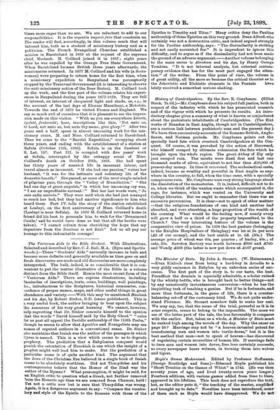History of Cambridgeshire. By the Rev. E. Conybeare.
Stock. 7s.6d.)—Mr. Conybeare does his subject full justice, both in respect of the industry with which he has prosecuted research and of the vigour with which he presents its results. An intro- ductory chapter gives a summary of what is known or conjectured about the prehistoric inhabitants of Cambridgeshire. (The flint works of Brandon in East Anglia, though not in Cambridgeshire, are a curious link between prehistoric man and the present day.) We have then successively accounts of the Romano-British, Anglo- Saxon, and Norman periods. Mr. Conybeare points out the specially hard fate which overtook Cambridgeshire at the Con- quest. Of course, it was provoked by the action of Hereward, who himself escaped by ultimate submission the fate which he brought upon the whole region. The great Abbey of Ely only just escaped ruin. The monks were fined first and last one thousand marks of silver, equivalent to not less than .£20,000 of present-day money. In time it recovered. The ecclesiastical caste, indeed, became as wealthy and powerful in East Anglia as any- where in the country, to fall, when the time came, with a specially conspicuous ruin. Mr. Conybeare uses very strong language about the dissolution of the monasteries. It is, indeed, difficult not to do so, when we think of the wanton waste which accompanied it, the rage, for instance, which was vented on the University and College libraries. But we ought to remember that there was an excessive provocation. It is clear—not to speak of other matters' —that the religious foundations of one kind and another had absorbed, and were absorbing, a huge proportion of the wealth of the country. What would be the feeling now, if nearly every will gave a half or a third of the property bequeathed, to the Church ? One very interesting feature of the volume is the, comparative view of prices. In 1338 the best pasture (belonging to the Knights Hospitallers of Shinghay) was let at 2s. per acre (.E2 of our money), and the best arable at is. 6d. (302.) The average price of wheat was 60s. per quarter ; of barley, 40s.; of oats, 20s. Sawston Rectory was worth between 2600 and .£700 and Wendy £266 (the latter is now put down at .£167 gross).


































 Previous page
Previous page